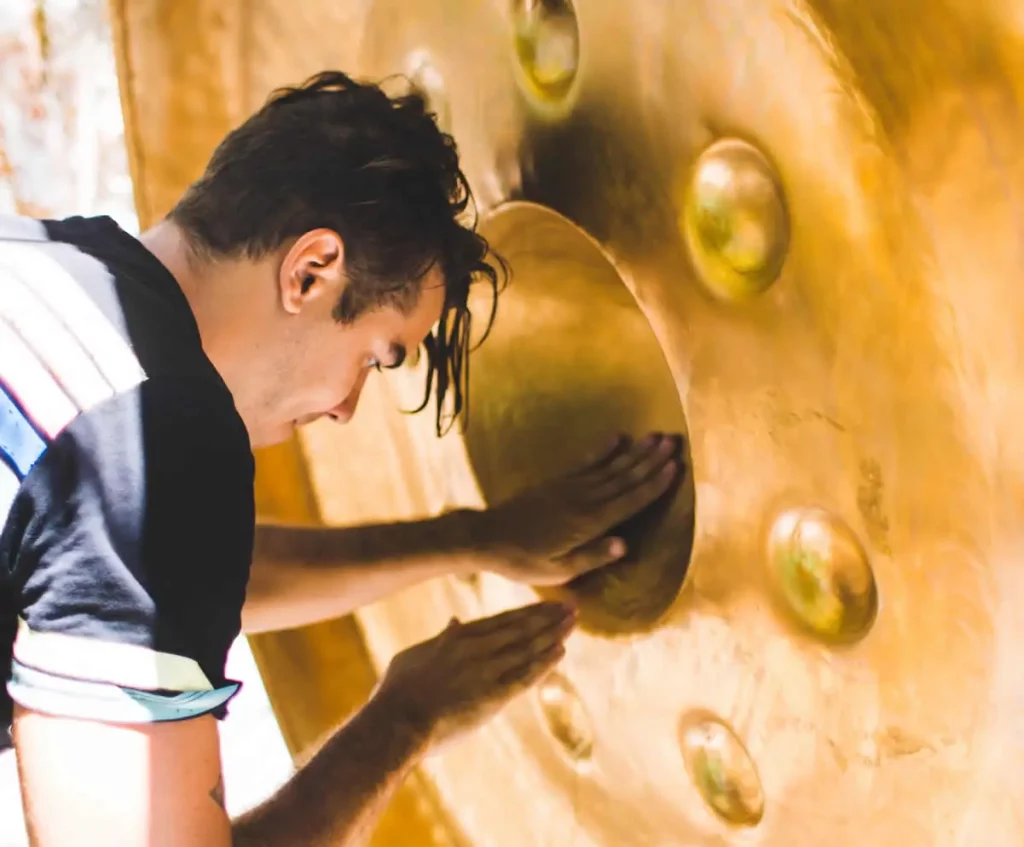Have you ever experienced feeling sick after a gong bath? You’re not alone.
While gong baths are known for their potential healing benefits, there are also possible side effects that some individuals may encounter during or after a session.
Understanding these reactions can help you navigate your own gong bath experience and ensure a safe and effective healing journey.
A gong bath, a form of sound healing, involves the use of gongs and other instruments to create deep vibrations and resonant sounds.
These vibrations can penetrate the body and evoke various physical, emotional, and energetic responses.
Although the majority of people find gong baths deeply relaxing and uplifting, it’s essential to recognize that some individuals may have different reactions.
So, if you’re asking yourself “Why do I feel sick after a Gong bath”, then this article will help you to answer this particular question.

Content
Potential Side Effects of Sound Bath Healing
During a sound healing session, you may experience overstimulation or discomfort from loud or repetitive sounds.
This can occur due to personal sensitivity or preferences. Additionally, certain frequencies or vibrations used in sound healing may cause nausea or dizziness, especially in individuals who are susceptible to these sensations.
To ensure a comfortable and effective healing experience, practitioners must be mindful of these potential side effects.
They should adjust their techniques or instruments accordingly, taking into consideration the individual needs and sensitivities of each client.
By creating a harmonious and balanced sound environment, practitioners can help minimize overstimulation and discomfort, allowing you to fully benefit from the healing properties of sound therapy.
| Potential Side Effects | Causes |
|---|---|
| Overstimulation or discomfort | Loud or repetitive sounds |
| Nausea or dizziness | Certain frequencies or vibrations |
Other Negative Effects of Gong Baths
While gong baths can offer numerous benefits, it’s essential to be aware of potential negative effects that some individuals may experience.
Apart from the previously mentioned side effects, such as overstimulation and discomfort from specific frequencies or vibrations, there are several other factors to consider.
Sensory Sensitivity
For individuals with sensory sensitivities, the loud sounds and intense vibrations of a gong bath can be overwhelming and distressing. The sensory overload during the session may cause feelings of discomfort and unease.
Physical Discomfort
Some people may experience physical discomfort during or after a gong bath, particularly if they have underlying medical conditions or musculoskeletal issues.
The intense vibrations and sounds can exacerbate pre-existing discomfort or cause new sensations of pain or discomfort.
Emotional Release
A gong bath can facilitate deep emotional release, which can be both cathartic and overwhelming.
This emotional release may bring forward unresolved trauma or intense feelings that require further processing and support.
Headaches or Dizziness
In rare cases, the intensity of the sounds and vibrations produced during a gong bath can lead to headaches or dizziness.
This can occur due to the powerful impact of the stimuli on the senses and the body’s response to the stimulation.
Unresolved Trauma
Individuals with unresolved trauma or post-traumatic stress disorder (PTSD) may find that certain elements of the gong bath trigger distressing memories or emotions related to their trauma.
These individuals must approach gong baths with caution and seek appropriate support from qualified professionals.
Disrupting Sleep Patterns
Due to the intense nature of the gong bath experience, some individuals may find that it disrupts their sleep patterns.
The heightened sensory stimulation and emotional release can impact the body’s ability to relax and transition into a restful state of sleep.
By understanding these potential negative effects and acknowledging individual differences, both practitioners and participants can take appropriate precautions to ensure a safe and beneficial gong bath experience.
| Negative Effects | Causes |
|---|---|
| Sensory Sensitivity | The loud sounds and intense vibrations can be distressing for individuals with sensory sensitivities. |
| Physical Discomfort | Gong baths may exacerbate physical discomfort in individuals with certain medical conditions or musculoskeletal issues. |
| Emotional Release | Gong baths can facilitate deep emotional release, which may bring forward unresolved trauma. |
| Headaches or Dizziness | The intensity of the sounds and vibrations can sometimes lead to headaches or dizziness. |
| Unresolved Trauma | Gong baths may trigger distressing memories or emotions for individuals with unresolved trauma or PTSD. |
| Disrupting Sleep Patterns | The intense nature of the gong bath experience may disrupt sleep patterns. |
Importance of Individual Differences and Precautions
When it comes to sound healing and gong baths, it is crucial to recognize and honor the significance of individual differences.
Every person is unique, with their preferences, sensitivities, and past experiences that can greatly influence their response to these therapeutic practices.
As a practitioner, it is essential to consider the specific needs and preferences of each individual. This may involve adapting your techniques, adjusting the volume or intensity of the sounds, or customizing the therapy to cater to their comfort levels.
By tailoring the experience to suit the individual, you create a safe and positive environment for their healing journey.
Open communication is another vital aspect of sound healing. Encourage your clients to express any discomfort or concerns they may have during or after the session. Actively listen to their feedback and address their needs accordingly.
This collaborative approach fosters trust, allows for personalized adjustments, and ensures that the healing process is effective and meaningful.
On an individual level, it is equally important for you to be in tune with your own body and emotions.
Pay close attention to how you feel during a session and communicate any discomfort or adverse reactions to the practitioner. By being proactive and responsive, you can work together to tailor the experience to your specific requirements.
Seeking Professional Guidance
If you have any pre-existing medical conditions, it is advisable to consult with a healthcare professional before engaging in sound healing practices.
They can offer insights and guidance specific to your health situation, helping you make informed decisions about participating in gong baths.
Remember, sound healing is a form of holistic therapy that aims to promote well-being and balance.
By respecting and embracing individual differences, and taking necessary precautions, you can embark on a transformative healing journey that is tailored to your unique needs.

Conclusion
So, why do you feel sick after a Gong bath can be attributed to various factors such as overstimulation, discomfort from certain frequencies or vibrations, and individual differences? It is important to approach sound healing with care and awareness, while also prioritizing self-care and open communication with practitioners.
By understanding the potential side effects and taking necessary precautions, individuals can have a safe and positive gong bath experience.
Gong baths have the potential to provide significant benefits for stress reduction, pain management, and immune system support.
However, it is crucial to recognize that not everyone will have the same experience. Individual differences, including personal sensitivity, past traumas, and sensory preferences, can greatly affect the response to sound healing therapies.
To ensure a successful gong bath session, it is important to prioritize self-care. This includes listening to your body, communicating any discomfort or concerns with your practitioner, and seeking professional guidance if needed.
Each person’s healing journey is unique, and a personalized approach to holistic healing is invaluable.
